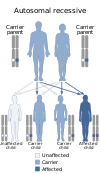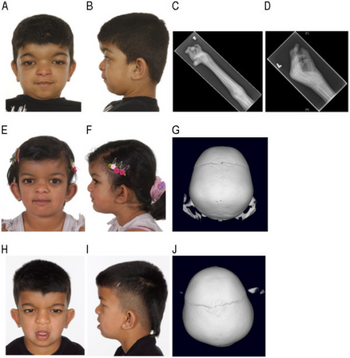Frank–Ter Haar syndrome
Frank–Ter Haar syndrome (FTHS), also known as Ter Haar-syndrome, is a rare disease characterized by abnormalities that affect bone, heart, and eye development. Children born with the disease usually die very young.
Signs and symptoms
The primary characteristics of FTHS are brachycephaly (flat head), wide fontanelle (soft spot on a baby’s head), prominent forehead, hypertelorism (abnormally wide distance between the eyes), prominent eyes, macrocornea (large corneas), optic disc edema, full cheeks, small chin, bowing of the long bones in the arms or legs, and finger deformities. Protruding, simple ears and a prominent coccyx (tailbone) are also regarded as important diagnostic signs of FTHS.[1]
Genetic

Genetic mapping in several families with FTHS linked the disease to an inherited mutation in the gene that codes for the protein Tks4.[2]
Tks4 was already known for its role in the formation of cellular projections known as podosomes, which allow cells to migrate.[3]
A mouse model that lacks the Tks4 gene shows all the symptoms of FTHS confirmed the hypothesis that Tks4 mutation is responsible for the disease.[2]
Diagnosis
The diagnosis for Frank–Ter Haar syndrome is done via the following:[4]
- Genetic test
- Lab test
- Physical exam
- Clinical presentation
- Medical history
Treatment
There is no treatment for FTHS, though identification of TKS4 mutation as a causative factor may eventually provide new opportunities for neonatal screening in high-risk families.[citation needed]
History
In 1973, researchers led by Yitzchak Frank, most recently at Mount Sinai Hospital in New York, described an 18-month-old Bedouin girl, born to consanguineous parents, who presented with enlarged corneas, multiple bone abnormalities, and developmental delay.[5] In 1982, Dutch pediatrician Ben ter Haar reported on three similar patients thought to have Melnick–Needles syndrome.[6] Over the next twenty years, several more similar cases were identified and eventually attributed to a new disorder, now called Frank–Ter Haar syndrome. FTHS is distinguished from other similar conditions based on its pattern of inheritance and association with congenital glaucoma and congenital heart disease.[1]
References
- ↑ 1.0 1.1 Maas SM, Kayserili H, Lam J, Apak MY, Hennekam RC (December 2004). "Further delineation of Frank–Ter Haar syndrome". American Journal of Medical Genetics Part A. 131 (2): 127–33. doi:10.1002/ajmg.a.30244. PMID 15523657. S2CID 33406414.
- ↑ 2.0 2.1 Iqbal Z, Cejudo-Martin P, de Brouwer A, et al. (February 2010). "Disruption of the podosome adaptor protein Tks4 (SH3PXD2B) causes the skeletal dysplasia, eye, and cardiac abnormalities of Frank–Ter Haar Syndrome". American Journal of Human Genetics. 86 (2): 254–61. doi:10.1016/j.ajhg.2010.01.009. PMC 2820172. PMID 20137777.
- ↑ Buschman MD, Bromann PA, Cejudo-Martin P, Wen F, Pass I, Courtneidge SA (March 2009). "The novel adaptor protein Tks4 (SH3PXD2B) is required for functional podosome formation". Molecular Biology of the Cell. 20 (5): 1302–11. doi:10.1091/mbc.E08-09-0949. PMC 2649273. PMID 19144821.
- ↑ "Frank Ter Haar syndrome | Genetic and Rare Diseases Information Center (GARD) – an NCATS Program". rarediseases.info.nih.gov. Archived from the original on 18 March 2021. Retrieved 25 September 2021.
- ↑ Frank Y, Ziprkowski M, Romano A, et al. (June 1973). "Megalocornea associated with multiple skeletal anomalies: a new genetic syndrome?". Journal de génétique humaine. 21 (2): 67–72. PMID 4805907.
- ↑ Ter Haar B, Hamel B, Hendriks J, de Jager J (December 1982). "Melnick-Needles syndrome: indication for an autosomal recessive form". American Journal of Medical Genetics. 13 (4): 469–77. doi:10.1002/ajmg.1320130418. PMID 7158646.
External links
| Classification | |
|---|---|
| External resources |
